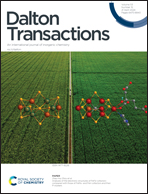Circularly polarized blue fluorescence based on chiral heteroleptic six-coordinate bis-pyrazolonate-Zn2+ complexes†
Abstract
Applying molecular design to chiral organo-Zn2+ complexes, a new pair of chiral heteroleptic bis-pyrazolonate-Zn2+ enantiomers [Zn(PMBP)2(1R,2R-Chxn)] (R,R-Zn2+; HPMBP = 1-phenyl-3-methyl-4-benzoyl-5-pyrazolone and 1R,2R-Chxn = (1R,2R)-cyclohexane-1,2-diamine) and [Zn(PMBP)2(1S,2S-Chxn)] (S,S-Zn2+; 1S,2S-Chxn = (1S,2S)-cyclohexane-1,2-diamine) have been synthesized and characterized in terms of photophysical and thermodynamic properties. In addition to a small Flack parameter (0.05(3)) associated with the solid-state elucidation of S,S-Zn2+, the circular dichroism (CD) and circularly polarized light (CPL) spectra for the chiral Zn2+ enantiomers show perfect mirror symmetry, establishing that the enantiopure 1,2-diamines successfully induce the optical isomerism of R,R-Zn2+ and S,S-Zn2+. As a result of the combined strong chiral induction capability of chiral 1,2-diamines and excellent photophysical properties of the pyrazolone ligand (PMBP)−, the two Zn2+ enantiomers exhibit high-quality pure blue fluorescence (ΦPL = 9–10%) and significant CPL activity (|glum| = 0.0065–0.0068). The heteroleptic strategy adopted in this study offers a new route to develop high-performance chiroptical luminophores.



 Please wait while we load your content...
Please wait while we load your content...